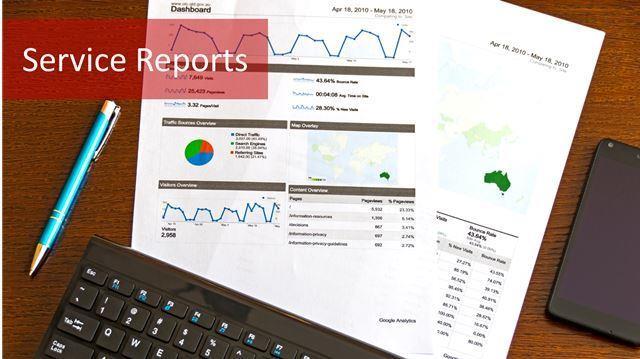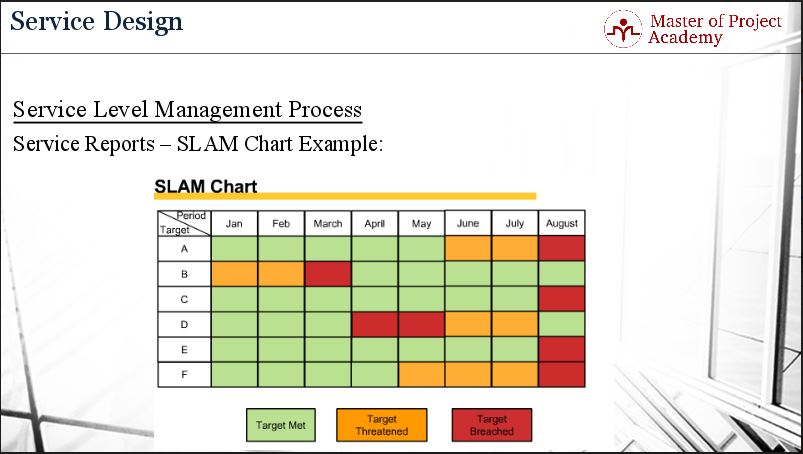ITIL Service level management has many tasks and activities. These are stipulated in ITIL foundation training. One of these tasks is to compile service reports. The purpose of the service report is to give both the business and the IT service provider enough information to make informed decisions regarding the service. Setting up the framework for a service report according to the methodologies communicated in free ITIL training is part of the Service Design phase of the ITIL lifecycle.

Producing service reports is another process activity of ITIL Service Level Management process. Immediately after the service level agreement (SLA) is agreed and accepted, monitoring of the service quality must be started. All services of an IT service provider are planned, designed, implemented and tested to meet the agreed service levels in a live environment.
However, the planned service levels might not be met in a live environment. Therefore, all services provided in a live environment must be monitored and checked whether the agreed service levels on SLAs are met. And the service performance outputs are recorded, documented and reported in service reports periodically.
IT Service Level: Setting up service reports in the Service Design stage
During the ITIL Service Design stage of the ITIL service lifecycle, several points need to be attended to.
- The designing of standard measures and service measurement data formats to achieve organizational serve measurement objectives.
- The designing of standard reporting procedures
- The designing of service measurement and service reporting awareness programs, and controls and governance mechanisms.
- The designing of the procedure for modifying, adding, or deleting measurements and reports.
IT Service Level: Who should see the service report?
The service report should be aimed at all stakeholders who are invested in the service. Internal IT reports should be provided to various managers. It may be necessary to prepare different service reports for different audiences, although the IT team should do their best to standardize service reports as this will save time in compiling reports in the future. Service reports could also be presented to external parties and customers and in this case, their specific needs should be addressed in the service report.

How and when should service reports be delivered?
The SLA reporting mechanisms, intervals, and reporting format must be defined and agreed with the customer. For instance, what should be included in the service reports? What will be the technical depth of the service reports? What will be the delivery frequency of the service reports? Monthly, weekly or bi-weekly etc. How will the service reports be delivered to the customer? Will it be sent via email, or will it be presented in a meeting? These are all negotiated with the customer and service reports are generated and delivered based on agreed frequency and format.
What should a service report include?
Service Reports should include a detailed performance evaluation of the services against all SLA targets. In order to check how the performance of the service exceeds or fall short of the SLA targets, the actual performance of the services should be included with the agreed targets on the service reports. By this way, a simple and fast comparison can be done to see which service met or exceeded the target and which service could not meet its targets. In addition, the service report should contain information on the target groups of the service delivered and the basis for calculations of the performance metrics.
Checklist for an IT service report
To ensure that all the necessary information is captured in the service report, the following checklist can be used:
- Name of the IT service provider
- Date and time of the review
- Time period covered by the review
- Person in charge of the review
- Business and user representatives as well as IT service provider representatives
- Service level summary
- Report on exceptional situations
- Customer satisfaction: compliments and complaints
- Room for improvement (Areas which must be addressed by improvement initiatives resulting in changes to the service and/ or to its underlying processes, or to customer agreements)
Using such a checklist is one way of standardizing a service report structure.
IT Service Level: Using a SLAM chart
A useful technique is to include an SLA monitoring chart at the front of a service report to show which services met the target and which services could not meet the targets briefly. This kind of SLA monitoring chart is called a SLAM chart. In this example of a SLAM chart. you’ll see that each service level target is highlighted in each month based on the actual performance of the service, whether it met the target, threatened the target or breached the target.
If we consider the target A in this chart, it has been met during January, February, March, April, and May and highlighted as green since it met the target during these months. In June and July, the target has been met barely. Therefore these months are highlighted as orange in the SLAM chart. And in August, the target could not be met and therefore, it has been highlighted as red in the SLAM chart. These kinds of SLAM charts can be placed in the beginning of service reports in order to give a brief outcome of the actual service performance against SLA targets.

Creating a service report that is useful
The success of all service management processes depends upon how the business use the information from the service reports. The management decisions, together with corrective action, must be based on the results of the service reports and communicated to all relevant parties. Less is often more. This applies very specifically in the case of service reports. Service reports should only be produced on the basis of agreed and documented customer requirements and those of the internal IT management. In this context, the relationships with both internal as well as external suppliers should also be illustrated to enable the entire service chain to be reviewed.
The design of service reports is just as important as designing a service during the Service Design stage of the ITIL service lifecycle as stated in the ITIL course as well. Effective service reports will allow the company to make informed decisions regarding the future of the service when the service is operational. Effective service reports will add value to the company.
Review by: Ethan Fox
